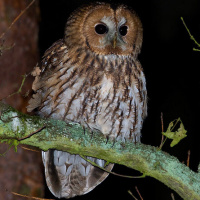Introduction
Since owls are very difficult to study, there is little research on them carried out in north-eastern Poland, and only a dozen or so studies in the whole country. These consider mainly species' distribution and number. The following article refers to different studies and a collectively prepared Polish Ornithological Atlas. We have led investigations into owls in the north-east since 1978. Large areas be Studied together 10 surface (Mammen & Stubbe, 1997). These data are on the areas of all Poland the superiors. The investigation has taken into account the remaining part of Poland here by different authors. This article also takes into account my study "Owls, Strigiformes - distribution, number, dangers, protection and parts in the biocenosis of north-eastern Poland" (Domaszewicz 2000). Gathered information include the years 1990-2004.
Tawny owl (Strix aluco)
Is not very numerous species. In north-eastern Poland the breeding population is approx. 4.200 pairs, which is almost 9% of country's population 48.000-50.000 pairs. Tawny owl is a protected breed. Its number is stable, although in some places a slight decrease is observed (Domaszewicz 1992, 1993, 2000; Dombrowski et al. 1991; Szmal et al. 1991; Wuczyński 1994).
Density:
deciduous forests; 10-20 pairs per 10 km2
coniferous forests; 2,5-10 pairs per 10 km2
agricultural areas; 1,5 pairs per 10 km2
city; 1-4,5 pairs per 10 km2
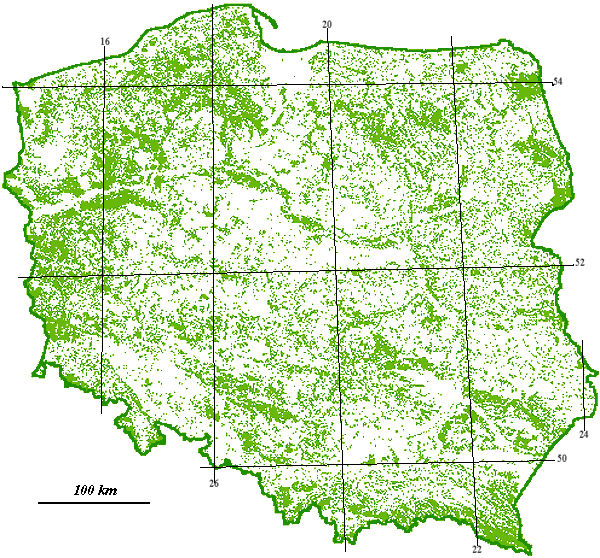
Long-eared owl (Asio otus)
Is scarce. In north-eastern Poland there are approximately 950-1.600 pairs depending on food availability. It is 14% of country's population 7.000-11.500 pairs. Long-eared owl is a protected species. Its number is changes intensely (Domaszewicz 1992, 1993; 2000, Dombrowski et al. 1991; Jermaczek et.al; Szmal et al 1991; Wuczyński 1994).
Density:
mixed forests; 0,4-4,3 pairs per 10 km2
agricultural areas; 0,3-5,2 pairs per 10 km2
Eagle owl (Bubo bubo)
Is a very rare breed. In north-eastern Poland there are on average 30-49 pairs, which is 15% country's population 260-290 pairs. Eagle owl is a protected species. All forestry works are forbidden in the 500 m range within nesting zone in summer and 200 m in winter. The breed is enlisted in Polish Red Book as it is very scarce. It is also protected under Bern Convention and Washington Convention regulations (Bednorz et al. 2000; Domaszewicz 1992, 1993, 2000; Pugacewicz 1995).
Density:
morass and forests; 0,5-1,8 pairs per 10 km2
mixed forests; 0,05-0,2 pairs per 10 km2
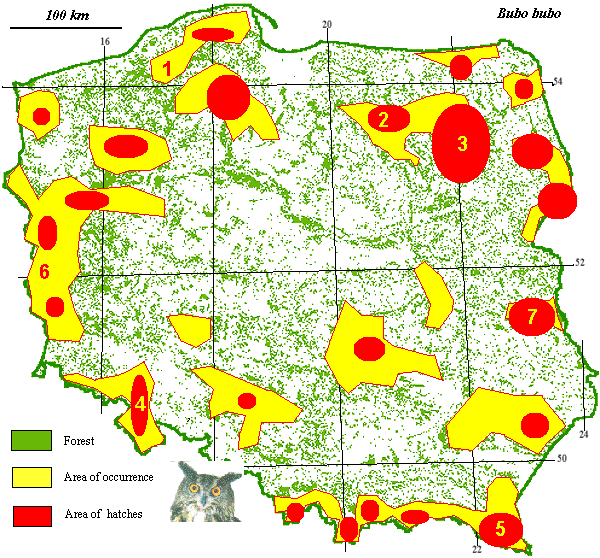
Tengmalm's owl (Aegolius funereus)
Is also rare, locally medium rare. In north-eastern Poland its population is approx. 200 pairs, which is 10% of country's population 1.800-2.000 pairs. The species is under protection (Bednorz et al. 2000; Błaszczyk 1999; Domaszewicz 1992, 1992a, 1993, 2000, 2001;
Density:
deciduous forests; 0,5-5,5 pairs per 10 km2
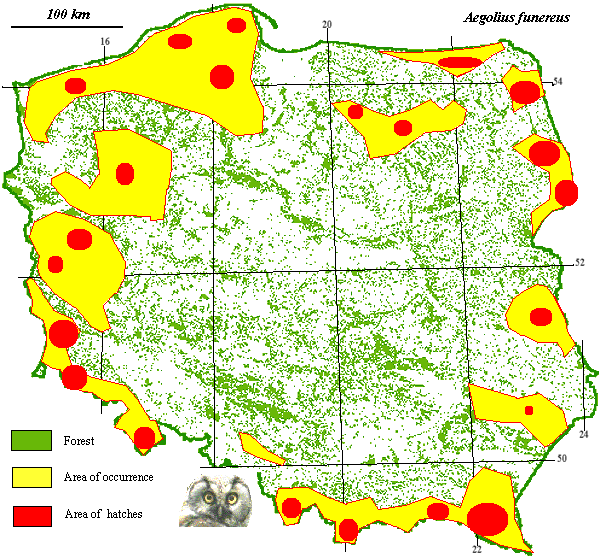
Aegolius funereus
Pygmy owl (Glaucidium passerinum)
Is a very rare breed. In north-eastern Poland its population is approx. 45-56 paris, which is 23% of country's population 220-300 pairs. The species is under protection. (Domaszewicz 1993, 1997, 2000; Mikusek 2001, 2001a)
Density:
deciduous forests; 0,2-3,5 pairs per 10 km2
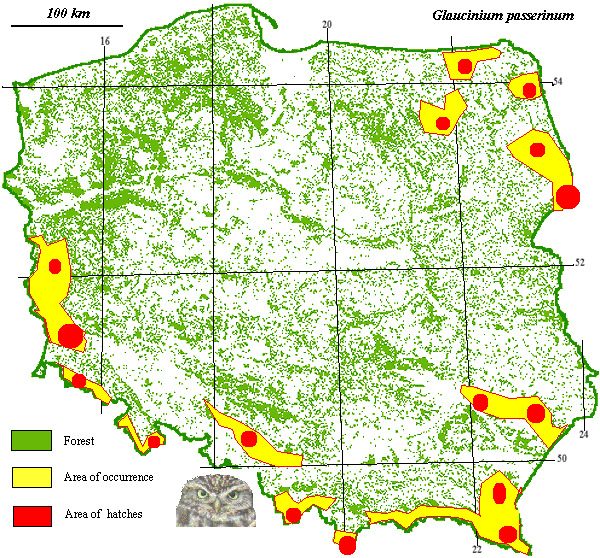
Glaucidium passerinum
Short-eared owl (Asio flammeus)
Is also a very scarce species. It is Poland's rarest owl breed, and it is possible that it will withdraw from Polish breeding grounds. The north-eastern Poland has the most numerous short-eared owls population. Its number in the Biebrza River Valley, depending on food availability, may reach 45 breeding pairs. Of country's population 100-400 pairs. The species is under protection (Domaszewicz 1995)
Density:
morass and meadow; 0,2-17,0 pairs per 10 km2

Asio flammeus
Barn owl (Tyto alba)
Is a very rare species. In north-eastern Poland the population is estimated at about 350-400 pairs, which is 16% of country's population 2.300-2.500 pairs. The species is under protection (Bednorz et al. 2000; Domaszewicz 2000; Dombrowski, et.al. 1991; Indyk 1996; Jermaczek 1990; Wuczyński 1994).
Density:
agricultural areas; 0,2-0,9 pairs per 10 km2
Litte owl (Athene noctua)
Is a very scarce species. There are approx 250-400 pairs of the breed north-eastern Poland, which is 10% of the country's population 3.500-4.000 pairs. The species is under protection (Bednorz et al. 2000; Domaszewicz 2000; Dombrowski, et.al. 1991; Grzywaczewski 2000; Jermaczek 1990; Wuczyński 1994).
Density:
agricultural areas; 0,2-6,8 pairs per 10 km2
Ural owl (Strix uralensis)
Does not nest in north-eastern Poland, although in easy food availability periods it is possible to find individual, ephemeral pairs in Rominck, Pisz and Augustów Primeval Forests. The country's population consists of 1.100-1.300 pairs it nests manly in Beskidy Mountains. The species is under protection (Domaszewicz 2000; Głowaciński 1992; Tomiałojć 1990).
Density:
mixed forests; 0,2-6,0 pairs per 10 km 2

Strix uralensis
Great Grey owl (Strix nebulosa)
Very thin. Hatches were confirmed in Białowieża primeval forest. It steps out in Augustowska Forest probably. Number several pairs. The species is under protection (Domaszewicz 1993, 2000).
Scops owl (Otus scops)
Thin. Can probably meet in south-east Poland several pairs. The species is under protection (Tomiałojć 1990).
Final notes
November Distribution and number of many species depends on the quality of their breeding biotopes. Apart from chemical fertilisation in agriculture and landscape urbanisation two factors describe the biotope quality: natural vegetation and atmos-phere pollution. The most endangered by pollution are Tengmalm's owl, (A.funereus) eagle owl, (B.bubo), and short-eared owl, (A.flammeus). This is obvious since owls are at the end of food chain. More immune species are long-eared owl, (A.otus) and Tawny owl ,(S.aluco). Barn owl, (T.alba) and little owl, (A.noctua) seem to be to some degree immune to the environment pollution.

